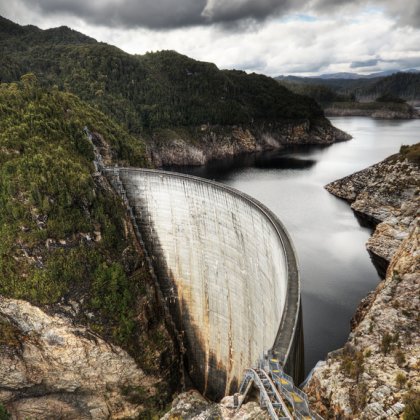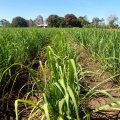
By UQ School of Geography Planning and Environmental Management Lecturer Joshua Larsen, School of Civil Engineering Lecturer Badin Gibbes and School of Economics Professor John Quiggin.
Originally published on The Conversation
The agricultural green paper released last week proposes 27 new water and irrigation projects, which the government claims will be necessary for Australia’s agricultural expansion. The emphasis is firmly on dams, with federal agriculture minister Barnaby Joyce arguing that “water is wealth and stored water is a bank".
Joyce also implied that dam-building has hit a slump, blaming the environmental movement’s hostility to dams. But how do the new projects stack up to Australia’s dam-building past? And are they what Australia needs in the future?
The proposed dam and irrigation projects are divided into three categories: six projects being considered for capital investment in the next 12 months; four more being considered for later investment; and the remaining 17 whose feasibility is yet to be confirmed.
Only 14 of these 27 have storage capacity estimates, and at least two are expansions of existing dams. The future for dams is far from clear, but in the meantime perhaps we can learn some lessons by looking to the past.
Dam useful
We have always needed to store water beyond what can be naturally sourced at any one time, and stopping the natural flow of a river has proven to be the most effective way to do this.
From ancient structures, to improved medieval designs, to today’s massive structures, the science has grown ever more sophisticated.
Regardless of their design, the purpose of dams is usually a combination of: agricultural, industrial, or domestic water supply; hydroelectric power generation; and flood mitigation.
Stopping or impeding the natural run of a river can create social, economic, and environmental impacts. That means that any touted benefits must have a clear economic and water-management rationale.
Australia’s dams: a potted history
Australia has a long history of dam building, albeit with considerable variation in intensity. Our biggest single effort was the Snowy Mountains scheme, one of the largest hydraulic engineering projects of its day.
Elsewhere, projects have been more modest. Dams need reliable water inflows, suitable landscapes to create a reservoir, and water users either near the dam or downstream. Australia has plenty of potential water users, but has typically fallen down on the first two considerations.
As a result, Australia’s rapid rise in dam construction from the 1960s to the 1980s petered out in the 1990s (although so did the worldwide trend).

As dam construction has faltered, overall water storage capacity has flatlined, within Australia and elsewhere.

This is not necessarily through a lack of will. It may be that, given the ingredients required for success (inflow, landscape and customers), Australia is simply running out of feasible locations for new dams.
Building dams in areas with marginal water inflow risks even greater storage variability than experienced by the current water storage network. Extending into areas with less-than-ideal landscapes increases the risk of construction cost blowouts or excessive water loss through evaporation.
It is probably no coincidence then that of the six dams to be considered for capital investment in the next 12 months, five are in Tasmania, a state rich in the essential physical (but not necessarily economic) characteristics.
Do the new plans hold water?
Most of the dams proposed for investment in the next 12 months are relatively small, with the 23,400-megalitre Circular Head in Tasmania being the largest of these.
Looking ahead, there are two dams to be considered for further investment with storage estimates, including Queensland’s 880,000-megalitre Nathan Dam proposal. The largest of the 14 dams is by far Urannah Dam at 1.5 million megalitres, but is lower down on the feasibility consideration list.
These 14 dams all have considerably less capacity than existing dams in Australia, the biggest of which is Gordon Dam in Tasmania, which stores 12.5 million megalitres.
There is also the question of who will pay to build them. Historically, most major Australian irrigation dam projects have been constructed by the public, and there has been little or no attempt to secure a return on the investment.
For much of the 20th century, water charges for irrigation did not even cover the costs of dam operation and maintenance. It seems unlikely that many existing projects would have been economically feasible if users had been required to bear the full cost.
The Ord River Scheme in Western Australia provides a good (if somewhat extreme) example. According to an official analysis, between 1958 and 1991 the government invested A$613 million in the scheme, but the benefits were just A$102 million. Yet the expansion of the project has continued (and is mentioned in the new green paper), with mounting net losses.
An uncertain future
Dams are inevitably linked to the climate in which they are constructed. Rainfall supplies the streams which flow into the dams, and how this relationship might respond to a changing climate is the subject of intense scientific debate.
The dam’s surface area determines how sensitive the storage is to evaporation, although the actual evaporation rate depends on the local climatic conditions.
If evaporation increases, this will increase the amount of water given to the atmosphere at the expense of use by agriculture or the environment.
Australia therefore needs a dam planning strategy that accounts for the whole water cycle, including the possible impacts of climate change.
Whether or not new dams can sustain the proposed agricultural expansions in the face of these climate-related uncertainties is a critical question, especially in northern Australia where conditions are already highly variable. A useful starting point is to acknowledge that a mix of both dam and non-dam infrastructure (such as groundwater, desalination, and water recycling systems) are likely to be needed, along with water use efficiency measures, to meet any expansion in agricultural water demand.
In terms of economics, it is unlikely that future schemes will do any better than the poor return on investment garnered from Australia’s existing dams. A century of development has exhausted most of the best dam sites, and new projects will face constraints that were less acute (or disregarded) during the expansionary period of the 20th century.
Moreover, while the real price of agricultural commodities has fluctuated about a stable or declining trend, the cost of large-scale construction of all kinds has increased – one of the few certainties in this entire issue.






_1 620W.jpg?itok=y7rQ1CJX)




